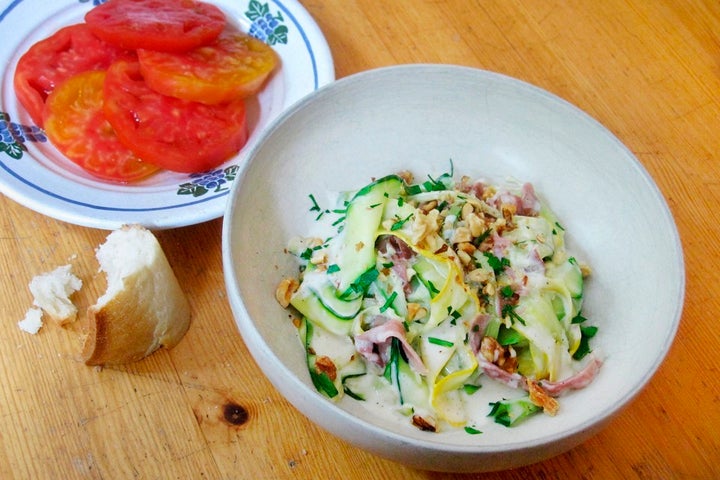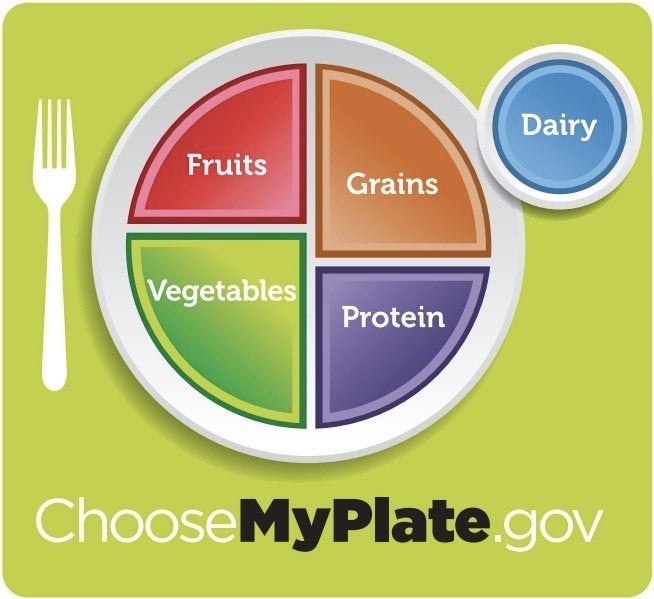
Zoodles—that’s short for “zucchini noodles”—are made with a kitchen gadget called a spiralizer, which shreds vegetables into long curly strands that enthusiasts compare, optimistically, to pasta.
The most committed have a spiralizer at home, which costs about $20 and is purportedly life-changing. Dabblers might shave zoodles with a vegetable peeler or buy them at Whole Foods, like I did, where they’re on display in the prepared foods section next to noodles made of squash and beets. Almost any dense vegetable can become a noodle (here's a guide); zoodles just have the catchiest name.
RELATED: The Organic Gatorade Illusion
Vegetable noodles are just one example of a growing dietary trend of replacement instead of restriction. Healthy eaters, rather than just eating bland plates full of plants or completely cutting out foods they’ve deemed unhealthy, instead are using fruits and vegetables to create fake versions of the things they crave. Some seem more reasonable than others: Ripened bananas, frozen and blended, become ice cream; avocados, when pureed with cacao, transform into chocolate pudding; layered sandwiches, carefully decorated, form a sort of cake. Others seem less so: Slices of sweet potato, when buttered, imitate toast; a watermelon, topped with other fruits is supposedly pizza; avocados, sliced strategically areburger buns, however impractical that may be.
And that’s just what I’ve seen on the internet this summer, popularized by Buzzfeed Tasty, Pinterest, and YouTube stars.
Admittedly, some of these substitutions are old. When my family moved to the United States in 1997 and I saw spaghetti squash for the first time, my mom told me that people used them like real spaghetti. And apparently sandwich cakes made with fish are a traditional Swedish dish. I went to a bar last year and got a carrot hot dog, which was successful in the sense that it, like a genuine weiner, was a squishy log of sodium. Kale chips are regular fare at most grocery stores now.
RELATED: What Do Chubby Kids Eat?
Regardless, health-conscious eating in 2016 seems perfectly primed for a movement like this. The health-conscious have survived ascetic diets like Atkins that forced them to order sad, bun-less burgers, or count points with Weight Watchers, or drink liquid meals like SlimFast and now Soylent. Meanwhile, the surge in gluten-free and vegan eating has led food manufacturers to create closer imitations—fake chicken is decent, having achieved the texture and taste of overcooked chicken breast, and gluten-free flours make passable bread.
This trend tells us that we can have as much pizza and ice cream and pasta as we want. We just have to convince ourselves that they can be made of summer produce. We can eat anything now and have it be healthy; the only thing required is some mental gymnastics.
While I have my share of skepticism—for me, sweet potatoes will never equal the crunch of real toast—I understand why this way of eating might be so appealing. For those of us who have struggled with the hand wringing of dieting, food is fraught territory. Eating what we want to eat, without feeling judged or guilty, can seem like an impossible task. Maybe these replacements allow for that.
Of course, there are critics. Eater recently declared that toasters are for toast, not the dubious sweet potato. New York magazine regularly runs the latest offenses of “fake junk food.”
RELATED: Feed a Cold, Don’t Starve It
But despite the critiques, evangelists are staunch in their claim that this “fake junk food” works—even to a life-changing extent, like it has for Ali Maffucci, who runs the popular blog Inspiralized.
Maffucci’s first exposure to vegetable noodles was in 2013 when her diabetic mother, who was trying a raw vegan diet at the suggestion of a nutritionist, made her a zucchini noodle bowl. That night, Maffucci took home her mother’s spiralizer and soon after, she left a job in corporate America—she once worked in event and hotel management for Trump Golf—to start Inspiralized, which she has since spun off into two cookbooks and a branded spiralizer.
“The whole concept of having your cake and eating it too: That’s what spiralizing is all about. It’s taking a big bowl of ‘pasta,’ having it, tasting it, and it tastes just like pasta, except you feel good after, and you’re nourishing yourself,” she said.
For Maffucci, who says she’s had had issues with portion control and restricting in the past, eating this way is liberating—and I imagine that’s the case for many followers of the “fake junk food” lifestyle. Instead of diets that constantly forbid, this diet says that with creativity, anything is on the table.
“Those restrictive diets, you get discouraged when you go off the plan,” she said. “I think people can get frustrated by all those rules and regulations. With this, you’re creating a healthier, more inspired version of the original dish, so I think it’s more sustainable.”
According to Maffucci, who comes from an Italian-American family, she hasn’t cooked real pasta at home since she started Inspiralized three years ago—though she hasn’t cut it out of her life and doesn’t intend to.
“If you’re craving spaghetti with alfredo and you eat sweet potatoes with alfredo, the texture of the noodle is so similar to that of pasta that your brain is tricked. The sauce is what you’re craving anyway,” she said. “I’d rather have a bigger bowl of noodles than the little cup that you need to portion control yourself with regular pasta.”
If you can convince yourself that sweet potato noodles are noodles, then you can eat bowls of pasta without guilt. While that may be a boon for eaters who feel limited by the suggested serving sizes of wheat noodles, people eating larger portion sizes of fake noodles could be one of the downfalls of this eating trend, according to Kathleen Keller, a professor of nutritional sciences and food science at Penn State University.
Keller suggested that this trend might inspire the Snackwell effect, named after Nabisco’s line of fat-free snacks: dieters tend to eat more of the non-fat or low-calorie version of a food (Snackwell’s cookies, for example) than they would the normal version of that food. A 2008 study found that participants ate about 35 percent more when a snack was regarded as healthy than when it was seen as unhealthy.
“In the past when we’ve tried to substitute healthier versions for the real thing, that ends up backfiring because people just think, ‘Well, I ate these really healthy noodles so I can put a really rich sauce on them,’” Keller said.
So while vegetable noodles might be visually similar to pasta, the texture and taste differ enough that they might not fulfill expectations of pasta, leading eaters to compensate with toppings or by eating more in order to achieve a similar effect.
What’s more, Keller explained, there’s not as much energy per gram in vegetable-based junk foods, so it’s unlikely that eaters will feel the same sort of post-meal reward from them as from the real thing. Humans tend to prefer foods with a lot of energy in them because our early ancestors wanted to get as many calories as possible per meal, since they didn’t always know when they’d get more. So typically, calorie-dense foods like ice cream activate brain regions associated with reward more than less caloric foods like salad.
The solution might be in the mindset eaters take when trying replacements like this. Keller likened them to veggie burgers: If you want and expect a real hamburger, you’ll be disappointed with a veggie burger. But if you go into the meal ready for a veggie burger that’s different from a hamburger and tasty in its own way, then you might be satisfied with that.
“They shouldn’t necessarily be pitched as pasta, but they might be pitched as a really creative way to eat these vegetables,” Keller suggested. “You just have to set your expectations in line. It’s a different kind of product, so I think there’s a place for them.”
This story originally appeared on TheAtlantic.com.
More from The Atlantic: When Donald Meets Hillary, Flat-Earthers Have a Wild New Theory About Forests
